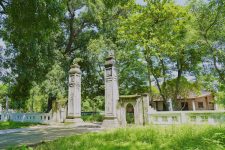
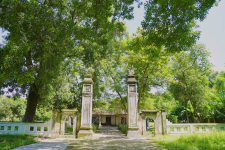
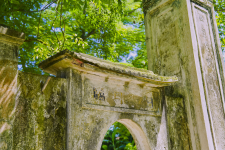
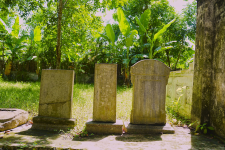
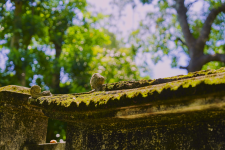

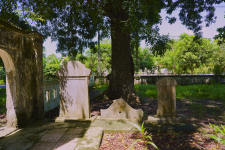
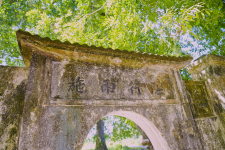
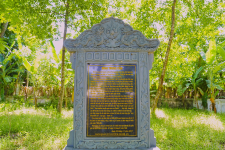
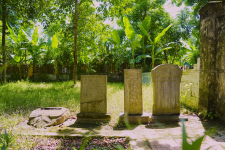
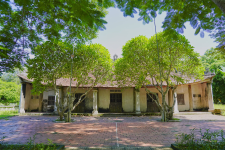
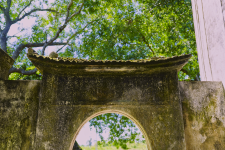
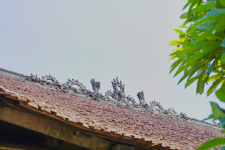
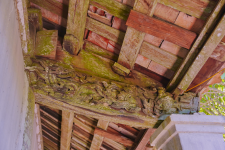
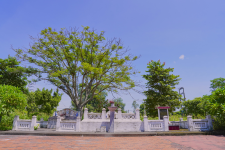
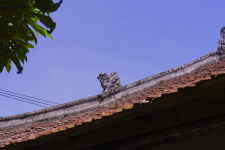
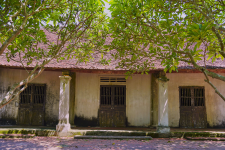
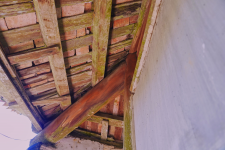
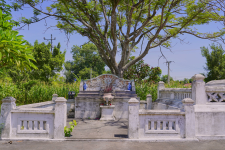
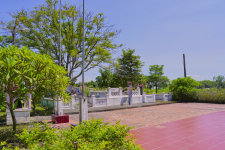
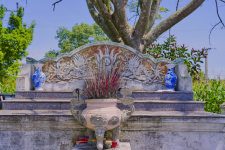
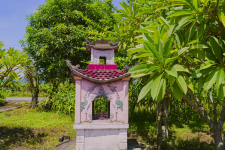
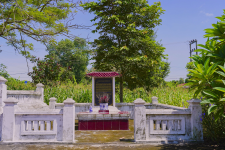
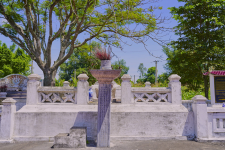
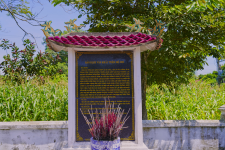
Camera tour
Price: Free
Time to visit a place: 120 phút
Open Time: 7:00 AM - Close Time: 6:00 PM
Address: Nam Trung Village, Nam Dan District, Nghe An Province
TRUNG CAN COMMUNAL HOUSE AND
TONG TAT THANG'S GRAVE - NAM DAN DISTRICT
Trung Can communal house in Nam Trung commune, Nam Dan district (now known as Trung Phuc Cuong commune) was started construction in Xin Chou year (the Buffalo year) (1781), chaired by 03 doctors with the surname Nguyen Trong, name Nguyen Trong Thuong, Nguyen Trong Duong, Nguyen Trong Duong, located on a high and airy strip of land, facing the South of Trung Can ancient village. The communal house was the place to worship the Emperor, Duke Tong Tat Thang (Thành hoàng Quận công Tống Tất Thắng) - he was a smart, brave man who obtained his doctorate at the age of 18, worked as a Minister of Officials, made many victories in fighting foreign invaders and protecting the country's borders under the Le dynasty. After winning the battle on the way back, he fell seriously ill and died at the age of 35. His grave was buried in Trung Can village and built in a beautiful campus, showing the admiration of the next generation for a famous general who has made contributions to the people and the country. In addition, there are also worships of Tam Tòa Đại Vương, four deities (Tứ Vị Đại Vương), Cao Sơn Cao Các at the communal house.
The communal house is a superficial, ancient and sophisticated art and culture work, showing the aesthetic awareness, high technical level and Confucian thought of the workers and people in the region.
In front of the communal house, next to the lowland dunes symbolizing study and exams in the "Ke pagoda" area is the tomb of Tong Tat Thang. The communal house wall is higher than the head, covering the four sides of the garden, with a walkway on the top, convenient for everyone to sit and watch the festival taking place in the courtyard. In front of the communal house gate is the a stone stele recording the legend of communal house and merits and names of those who have contributed their efforts, money and land to the construction of the communal house. The communal house door has 2 towering columns, above are two mascots made of terracotta with delicate and soft detailed patterns, facing the communal house, bearing the characteristics of the mascot of Le Trung Hung period. The communal house yard is flat, smooth green grass and many old trees. The majestic communal house, curved roof, has the image of "two Dragons adoring the moon" (symbol of two dragons winding opposite each other and in the middle is a circle representing the moon) on the roof, and densely embossed with sacred symbols of dragons, Nghe, and unicorns casted in terracotta running along the banks and corners of the roof, followed by phoenixes that spread their wings as if they want to fly to the sky.
The communal house has a four-pillar structure consisting of 5 compartments, 3 main compartments, 2 auxiliary compartments, length 30m, width 16.6m and truss consisting of 24 ironwood columns, each column is about 8m high and 1.5m in circumference. All 12 trusses front, back and side are delicately carved. Each corner on the beam is elaborately carved with a "dragon nest" relief. Eight dragon nests are eight round wooden lines carved around the dragon's head, curled in the corner of the roof, the head sticks out into space, the mouth holds pearls, the fangs and claws are soft, the lines are discreet and flexible flexible as real as a dream, the woodcarving lines in the communal house are very elegant but dense, both floating and sinking, all arranged in a delicate and harmonious shape.
The lower and upper beams are embossed with the theme "clouds, rain, juniper leaves, pineneedle, chrysanthemums, bamboo leaves, apricot flowers".On all beams were carved 24 paintings, these are masterpieces of ancient sculpture. The classics such as "King Thuan plowing", "King Nghieu passed the throne to King Thuan in the Royal Palace" were shown exquisitely, the scene of "Passing the boat in the storm", scenes of folk activities were very vivid such as "Doctor returns to the village", "lute player", "Buffalo-herding children play the flute", "mother breastfeeds her child", "Boy and girl pound the rice", "chess player", "The person who reads and recites poems", "Ride horses through the village".All are arranged to shape and form harmoniously, demonstrating wood carving techniques to a level of virtuosity. In the middle space, there is a horizontal painting carved in Chinese characters: "Holy Palace of ten thousand thousand years". Through the structure and arrangement of motifs, patterns, and carved paintings in the communal house showed the talent and harmonious combination between Confucian thought and folklore of the people at that time.
Behind the great communal house is the harem with a signboard carved with three Chinese characters: ''Dai Thanh Mieu'' presented by the villagers and Governor Le Nguyen Trung when he retired.
In the past, at the communal house, many important festivals took place every year, including the festival of blessings on February 15 (lunar calendar). Currently, the main ceremony of the communal house is held on October 13 (lunar calendar). With great values, in 1996, Ministry of Culture and Information (now known as Ministry of Culture, Sports and Tourism) ranked Trung Can Communal House and the tomb of Dr. Tong Tat Thang was a national historical - architectural and artistic relic according to Decision No. 51-VH/QD, dated January 12, 1996. Along with Hoanh Son communal house, Trung Can communal house has become a typical cultural address, included in the tourist route of Nghe An, attracting visitors from near and far to come to worship.
Distance: 11.19 km
Distance: 12.46 km
Distance: 12.51 km
Distance: 12.51 km
Distance: 12.64 km
Distance: 12.94 km
Distance: 13.12 km
Distance: 13.37 km
Distance: 13.47 km
Distance: 13.49 km
Distance: 13.53 km
Distance: 13.59 km
Distance: 13.68 km
Distance: 13.77 km
Distance: 13.79 km
Distance: 9.80 km
Distance: 9.88 km
Distance: 9.92 km
Distance: 10.13 km
Distance: 10.16 km
Distance: 13.27 km
Distance: 13.56 km
Distance: 13.67 km
Distance: 13.97 km
Distance: 14.08 km
Distance: 14.46 km
Distance: 14.47 km
Distance: 14.49 km
Distance: 14.64 km
Distance: 14.72 km
Distance: 14.76 km
Distance: 14.77 km
Distance: 14.85 km
Distance: 3.20 km
Distance: 5.60 km
Distance: 6.14 km
Distance: 6.14 km
Distance: 6.55 km
Distance: 7.01 km
Distance: 7.34 km
Distance: 7.58 km
Distance: 7.58 km
Distance: 7.63 km
Distance: 8.43 km
Distance: 8.74 km
Distance: 9.03 km
Distance: 9.04 km
Distance: 9.13 km
Distance: 13.20 km
Distance: 13.66 km
Distance: 13.86 km
Distance: 13.98 km
Distance: 14.16 km
Distance: 14.21 km
Distance: 14.22 km
Distance: 14.23 km
Distance: 14.23 km
Distance: 14.31 km
Distance: 14.32 km
Distance: 14.33 km
Distance: 14.39 km
Distance: 14.41 km
Distance: 14.44 km
Distance: 14.51 km
Distance: 14.71 km
Distance: 14.71 km


